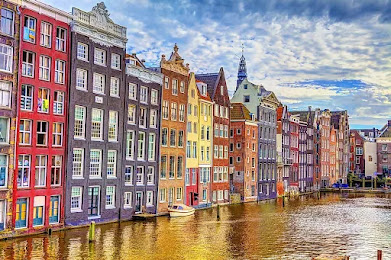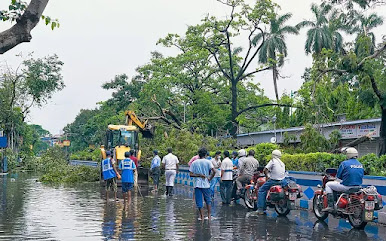.webp)
Source:World Atlas
Some cities around the globe are prone to sinkage more than others for various reasons, including low elevations, coastal locations, and areas subject to flooding from monsoons and heavy rains. The changing climate that melts polar ice also alters weather patterns, including more and more brutal storms for areas previously unaffected by such natural "annoyances." Regions that face food shortages and waterborne disease suffer more, with flood waters causing damage to the crops and spreading illnesses at an exponential rate.
Although many cities at risk of sinking have prepared and innovated themselves by erecting protective measures such as dams and levees, they must face the consequences of the continuous global warming trend and its natural effects, including intensifying disasters. Scientists predict that parts of these nine cities will be underwater by 2030.
Bangkok, Thailand

The famous tourist destination for all things dark and exotic for affordable American standards currently sits, sinking, at mere 1.5 meters above sea level. In fact, it is "drowning" much faster than many other cities in the world with the same fate, at an annual rate of about two to three centimeters. According to a 2020 study, the Thai capital is first in line to receive full-blow from the global warming effects. It is a short-term prediction, with more cities following suit, while Bangkok will continue into a spiraling downfall with little chance of recovering.
Moreover, the city, built on very dense yet soft clay soil, is prone to flooding. Scientists and the Guardian have reported that by 2030, most of the coastal Tha Kham and Samut Prakan areas and its main airport, Suvarnabhumi International, could all submerge underwater. The persistently heavy rainfall, rising water levels, and years upon years of groundwater extraction also have consequences in that the city will meet its fate sooner rather than later.
For a country where many live to survive, the floods cause further food insecurity and infrastructure damage, putting the lives of millions in immediate danger. The Thai National Reform Council reports that the capital city is likely to be in a detrimental position in under 15 years, and scientists predict that Bangkok will drown entirely by the next century. In 2017 the city inaugurated the "Chulalongkorn Centenary Park" green infrastructure to reduce urban flood risks and give citizens a nature-scape within the highly commercialized and industrious city. Current efforts to hold Bangkok above water and prolong its fate include improvements to some infrastructures, despite which the sinking persisted.
Other cities:
Although many cities at risk of sinking have prepared and innovated themselves by erecting protective measures such as dams and levees, they must face the consequences of the continuous global warming trend and its natural effects, including intensifying disasters. Scientists predict that parts of these nine cities will be underwater by 2030.
Bangkok, Thailand

Bangkok, Thailand
Flooding in the Thai capital of Bangkok. Editorial credit: Wutthichai / Shutterstock.com
Flooding in the Thai capital of Bangkok. Editorial credit: Wutthichai / Shutterstock.com
The famous tourist destination for all things dark and exotic for affordable American standards currently sits, sinking, at mere 1.5 meters above sea level. In fact, it is "drowning" much faster than many other cities in the world with the same fate, at an annual rate of about two to three centimeters. According to a 2020 study, the Thai capital is first in line to receive full-blow from the global warming effects. It is a short-term prediction, with more cities following suit, while Bangkok will continue into a spiraling downfall with little chance of recovering.
Moreover, the city, built on very dense yet soft clay soil, is prone to flooding. Scientists and the Guardian have reported that by 2030, most of the coastal Tha Kham and Samut Prakan areas and its main airport, Suvarnabhumi International, could all submerge underwater. The persistently heavy rainfall, rising water levels, and years upon years of groundwater extraction also have consequences in that the city will meet its fate sooner rather than later.
For a country where many live to survive, the floods cause further food insecurity and infrastructure damage, putting the lives of millions in immediate danger. The Thai National Reform Council reports that the capital city is likely to be in a detrimental position in under 15 years, and scientists predict that Bangkok will drown entirely by the next century. In 2017 the city inaugurated the "Chulalongkorn Centenary Park" green infrastructure to reduce urban flood risks and give citizens a nature-scape within the highly commercialized and industrious city. Current efforts to hold Bangkok above water and prolong its fate include improvements to some infrastructures, despite which the sinking persisted.
Other cities:
Miami, USA

Miami is highly vulnerable to flooding due to sea level rise.
Amsterdam, Netherlands

The various canal systems of Amsterdam are linked to the sea and susceptible to rising sea levels.
Basra, Iraq

The Shatt-al-Arab River flowing past Basra is a powerufl rivers connected to the Persian Gulf whose rising water levels makes Basra prone to flooding.
Georgetown, Guyana

Aerial view of Georgetown city where the Demerara River meets the Atlantic ocean. The city is extremely vulnerable to flooding due to sea level rise.
Ho Chi Minh City, Vietnam
.webp)
A flooded street in Ho Chi Minh City. The poor suffer the most during flooding incidents as they are forced to carry on with their daily activities despite the situation. Editorial credit: TU TEO TEO / Shutterstock.com
Kolkata, India

Disaster management task force clearing up fallen trees from Kolkata's flooded streets following the disastrous cyclone of Amphan in 2020.
New Orleans, USA

A flooded Jackson Square in the French Quarter of New Orleans following a hurricane.
Venice, Italy

Kolkata, India

Disaster management task force clearing up fallen trees from Kolkata's flooded streets following the disastrous cyclone of Amphan in 2020.
New Orleans, USA

A flooded Jackson Square in the French Quarter of New Orleans following a hurricane.
Venice, Italy

Gigantic hands rise from water to support the Ca’ Sagredo Hotel, a statement of the impact of climate change and rising sea levels. Editorial credit: Alena Veasey / Shutterstock.com
Read the original story at World Atlas
Read the original story at World Atlas

.jpg)





